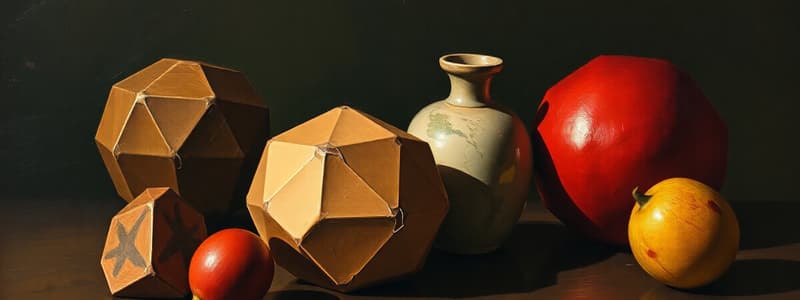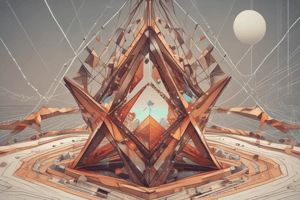Podcast
Questions and Answers
รูปทรงเรขาคณิต 2 มิติ สามารถนิยามได้โดยอะไร
รูปทรงเรขาคณิต 2 มิติ สามารถนิยามได้โดยอะไร
- เซตของจุดหรือจุดยอดและเส้นที่เชื่อมต่อจุดเหล่านั้นในห่วงโซ่ปิด รวมถึงจุดภายนอกที่เกิดขึ้น
- เซตของจุดหรือจุดยอดและเส้นที่เชื่อมต่อจุดเหล่านั้นในห่วงโซ่ปิด รวมถึงจุดภายในที่เกิดขึ้น (correct)
- เซตของจุดหรือจุดยอดและเส้นที่เชื่อมต่อจุดเหล่านั้นในห่วงโซ่เปิด รวมถึงจุดภายนอกที่เกิดขึ้น
- เซตของจุดหรือจุดยอดและเส้นที่เชื่อมต่อจุดเหล่านั้นในห่วงโซ่เปิด รวมถึงจุดภายในที่เกิดขึ้น
รูปทรงเรขาคณิต ______ มี 6 หน้า 12 ขอบ และ 8 จุดยอด
รูปทรงเรขาคณิต ______ มี 6 หน้า 12 ขอบ และ 8 จุดยอด
ปริซึมสี่เหลี่ยมมุมฉาก
รูปทรงเรขาคณิต 3 มิติทั้งหมดมี 6 หน้า
รูปทรงเรขาคณิต 3 มิติทั้งหมดมี 6 หน้า
False (B)
วงกลมมีด้านกี่ด้าน
วงกลมมีด้านกี่ด้าน
ระยะห่างรอบวงกลมเรียกว่าอะไร
ระยะห่างรอบวงกลมเรียกว่าอะไร
ระยะห่างจากจุดศูนย์กลางของวงกลมไปยังเส้นรอบวงเรียกว่าอะไร
ระยะห่างจากจุดศูนย์กลางของวงกลมไปยังเส้นรอบวงเรียกว่าอะไร
ระยะห่างที่ผ่านจุดศูนย์กลางของวงกลมจากด้านหนึ่งไปยังอีกด้านหนึ่งเรียกว่าอะไร
ระยะห่างที่ผ่านจุดศูนย์กลางของวงกลมจากด้านหนึ่งไปยังอีกด้านหนึ่งเรียกว่าอะไร
สูตรในการคำนวณพื้นที่ของวงกลมคืออะไร
สูตรในการคำนวณพื้นที่ของวงกลมคืออะไร
สูตรในการคำนวณเส้นรอบวงของวงกลมคืออะไร
สูตรในการคำนวณเส้นรอบวงของวงกลมคืออะไร
รูปทรงเรขาคณิตที่มีด้าน 3 ด้าน และมุม 3 มุมเรียกว่าอะไร
รูปทรงเรขาคณิตที่มีด้าน 3 ด้าน และมุม 3 มุมเรียกว่าอะไร
สี่เหลี่ยมที่มีด้านเท่ากัน 4 ด้าน และมุมฉาก 4 มุมเรียกว่าอะไร
สี่เหลี่ยมที่มีด้านเท่ากัน 4 ด้าน และมุมฉาก 4 มุมเรียกว่าอะไร
รูปทรงเรขาคณิตที่มีหน้าเป็นรูปสามเหลี่ยม 4 หน้า และฐานเป็นรูปสี่เหลี่ยมเรียกว่าอะไร
รูปทรงเรขาคณิตที่มีหน้าเป็นรูปสามเหลี่ยม 4 หน้า และฐานเป็นรูปสี่เหลี่ยมเรียกว่าอะไร
รูปทรงเรขาคณิตที่มีฐานเป็นวงกลมเรียกว่าอะไร
รูปทรงเรขาคณิตที่มีฐานเป็นวงกลมเรียกว่าอะไร
รูปทรงเรขาคณิตที่มีฐานเป็นวงกลม 2 อันตรงข้ามกัน และเชื่อมต่อด้วยผิวโค้งเรียกว่าอะไร
รูปทรงเรขาคณิตที่มีฐานเป็นวงกลม 2 อันตรงข้ามกัน และเชื่อมต่อด้วยผิวโค้งเรียกว่าอะไร
รูปทรงเรขาคณิตที่มีจุดศูนย์กลางและจุดบนพื้นผิวทั้งหมดอยู่ห่างจากจุดศูนย์กลางเท่ากันเรียกว่าอะไร
รูปทรงเรขาคณิตที่มีจุดศูนย์กลางและจุดบนพื้นผิวทั้งหมดอยู่ห่างจากจุดศูนย์กลางเท่ากันเรียกว่าอะไร
Flashcards
รูปทรงทางเรขาคณิต (Geometric shape)
รูปทรงทางเรขาคณิต (Geometric shape)
รูปทรงทางเรขาคณิตที่มีรูปร่างคงเดิม แม้จะถูกย้าย เปลี่ยนขนาด หมุน หรือสะท้อนก็ตาม
รูปทรงสองมิติ (2D Shapes)
รูปทรงสองมิติ (2D Shapes)
รูปทรงสองมิติที่มีด้านและมุม
รูปทรงสามมิติ (3D Shapes)
รูปทรงสามมิติ (3D Shapes)
รูปทรงสามมิติที่มีหน้า ด้าน และจุดยอด
ด้าน (Side)
ด้าน (Side)
Signup and view all the flashcards
มุม (Angle)
มุม (Angle)
Signup and view all the flashcards
หน้า (Face)
หน้า (Face)
Signup and view all the flashcards
ด้าน (Edge)
ด้าน (Edge)
Signup and view all the flashcards
จุดยอด (Vertex)
จุดยอด (Vertex)
Signup and view all the flashcards
วงกลมหน่วย (Unit Circle)
วงกลมหน่วย (Unit Circle)
Signup and view all the flashcards
รัศมี (Radius)
รัศมี (Radius)
Signup and view all the flashcards
เส้นผ่านศูนย์กลาง (Diameter)
เส้นผ่านศูนย์กลาง (Diameter)
Signup and view all the flashcards
เส้นรอบวง (Circumference)
เส้นรอบวง (Circumference)
Signup and view all the flashcards
พื้นที่วงกลม (Area of a circle)
พื้นที่วงกลม (Area of a circle)
Signup and view all the flashcards
ความยาว (Length)
ความยาว (Length)
Signup and view all the flashcards
ความกว้าง (Width)
ความกว้าง (Width)
Signup and view all the flashcards
ความสูง (Height)
ความสูง (Height)
Signup and view all the flashcards
ปริมาตร (Volume)
ปริมาตร (Volume)
Signup and view all the flashcards
พื้นที่ผิว (Surface area)
พื้นที่ผิว (Surface area)
Signup and view all the flashcards
การอ้างอิงตำแหน่งสัมบูรณ์ (Absolute reference)
การอ้างอิงตำแหน่งสัมบูรณ์ (Absolute reference)
Signup and view all the flashcards
การอ้างอิงตำแหน่งสัมพัทธ์ (Relative reference)
การอ้างอิงตำแหน่งสัมพัทธ์ (Relative reference)
Signup and view all the flashcards
การบวก (Addition)
การบวก (Addition)
Signup and view all the flashcards
การลบ (Subtraction)
การลบ (Subtraction)
Signup and view all the flashcards
การคูณ (Multiplication)
การคูณ (Multiplication)
Signup and view all the flashcards
การหาร (Division)
การหาร (Division)
Signup and view all the flashcards
การยกกำลัง (Power)
การยกกำลัง (Power)
Signup and view all the flashcards
รากที่สอง (Square root)
รากที่สอง (Square root)
Signup and view all the flashcards
รากที่สาม (Cube root)
รากที่สาม (Cube root)
Signup and view all the flashcards
รากที่ n (nth root)
รากที่ n (nth root)
Signup and view all the flashcards
สมการทางคณิตศาสตร์ (Equation)
สมการทางคณิตศาสตร์ (Equation)
Signup and view all the flashcards
ค่าคงที่ (Constant)
ค่าคงที่ (Constant)
Signup and view all the flashcards
ตัวแปร (Variable)
ตัวแปร (Variable)
Signup and view all the flashcards
Study Notes
Unit 1: Describing Objects and Math Basics
- Objectives: After completing this unit, students will be able to identify and describe geometric objects in English, using appropriate descriptive phrases, sentence structures, and verb phrases. Students will also be able to describe numbers and equations.
1.2 Introduction
- Learning English for describing places, people, and objects improves students' job prospects after graduation. This unit covers geometric objects, their properties, locations, and basic math.
1.3 Vocabulary
- Key terms for shapes and geometric objects are provided, including: shape, rectangle, triangle, ellipse, square, pyramid, sphere, edge, vertex, angle, radius, diameter, circumference, locate, situate, subtraction, division, addition, multiplication, and power.
1.4 Geometric Objects and Types
- Geometric shapes are described without considering their position, size or orientation.
- Two-dimensional (2D) shapes are defined by a set of points (vertices) and lines connecting those points. Examples include triangles, squares, and polygons, that are bounded by curves like circles or ellipses.
- Three-dimensional (3D) objects are described by a set of vertices, connecting lines, and 2D faces. Examples include cubes, pyramids, tetrahedrons, ellipsoids, and spheres. These shapes can be bounded by curves or surfaces.
1.5 Properties of Geometric Objects for Measurement
- 2D Shapes: 2D shapes focus on sides and angles. Angles are also known as vertices. For example, a quadrilateral has four sides and four angles.
- 3D Shapes: 3D shapes are focused on faces, edges, and vertices. Faces are the flat surfaces. Edges are the lines where faces meet. Vertices are the points where two or more edges meet..
1.6 Location
- Absolute Location: Describes the position of an object relative to a fixed point, such as "in the middle," "at the top," or "below."
- Relative Location: Describes the position of an object relative to another object, such as "next to," "above," or "below."
1.7 Math Basics
- 1.7.1 Reading Numbers: Examples of reading various numbers.
- 1.7.2 Equations: Examples of mathematical equations, including addition, subtraction, multiplication, division, and expressions involving powers. Examples are provided.
Studying That Suits You
Use AI to generate personalized quizzes and flashcards to suit your learning preferences.




